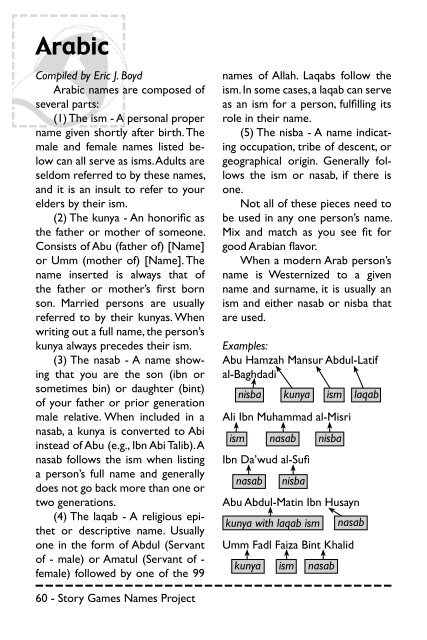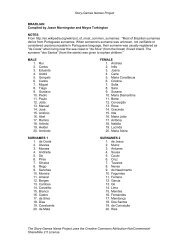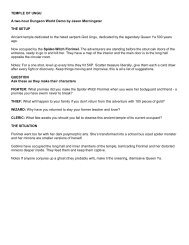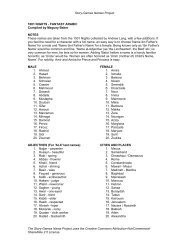The Story Games Names Project
The Story Games Names Project - Tistory
The Story Games Names Project - Tistory
- No tags were found...
Create successful ePaper yourself
Turn your PDF publications into a flip-book with our unique Google optimized e-Paper software.
Arabic<br />
Compiled by Eric J. Boyd<br />
Arabic names are composed of<br />
several parts:<br />
(1) <strong>The</strong> ism - A personal proper<br />
name given shortly after birth. <strong>The</strong><br />
male and female names listed below<br />
can all serve as isms. Adults are<br />
seldom referred to by these names,<br />
and it is an insult to refer to your<br />
elders by their ism.<br />
(2) <strong>The</strong> kunya - An honorific as<br />
the father or mother of someone.<br />
Consists of Abu (father of) [Name]<br />
or Umm (mother of) [Name]. <strong>The</strong><br />
name inserted is always that of<br />
the father or mother’s first born<br />
son. Married persons are usually<br />
referred to by their kunyas. When<br />
writing out a full name, the person’s<br />
kunya always precedes their ism.<br />
(3) <strong>The</strong> nasab - A name showing<br />
that you are the son (ibn or<br />
sometimes bin) or daughter (bint)<br />
of your father or prior generation<br />
male relative. When included in a<br />
nasab, a kunya is converted to Abi<br />
instead of Abu (e.g., Ibn Abi Talib). A<br />
nasab follows the ism when listing<br />
a person’s full name and generally<br />
does not go back more than one or<br />
two generations.<br />
(4) <strong>The</strong> laqab - A religious epithet<br />
or descriptive name. Usually<br />
one in the form of Abdul (Servant<br />
of - male) or Amatul (Servant of -<br />
female) followed by one of the 99<br />
names of Allah. Laqabs follow the<br />
ism. In some cases, a laqab can serve<br />
as an ism for a person, fulfilling its<br />
role in their name.<br />
(5) <strong>The</strong> nisba - A name indicating<br />
occupation, tribe of descent, or<br />
geographical origin. Generally follows<br />
the ism or nasab, if there is<br />
one.<br />
Not all of these pieces need to<br />
be used in any one person’s name.<br />
Mix and match as you see fit for<br />
good Arabian flavor.<br />
When a modern Arab person’s<br />
name is Westernized to a given<br />
name and surname, it is usually an<br />
ism and either nasab or nisba that<br />
are used.<br />
Examples:<br />
Abu Hamzah Mansur Abdul-Latif<br />
al-Baghdadi<br />
Ali Ibn Muhammad al-Misri<br />
ism<br />
nisba<br />
Ibn Da’wud al-Sufi<br />
nasab<br />
nasab<br />
kunya ism laqab<br />
nisba<br />
nisba<br />
Abu Abdul-Matin Ibn Husayn<br />
kunya with laqab ism<br />
Umm Fadl Faiza Bint Khalid<br />
kunya ism nasab<br />
nasab<br />
60 - <strong>Story</strong> <strong>Games</strong> <strong>Names</strong> <strong>Project</strong>
















